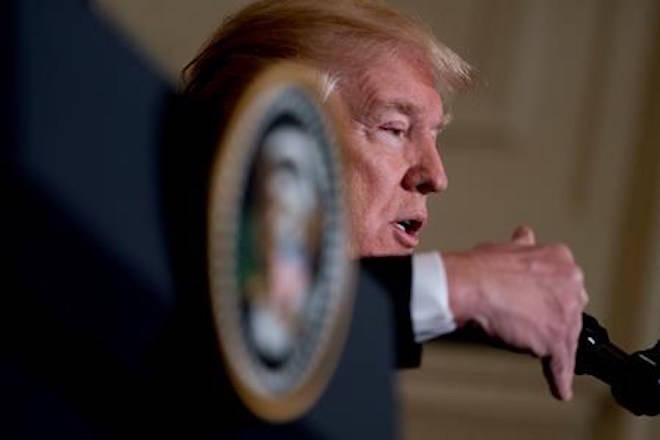The United States is suddenly proposing a sprint to the finish toward a new NAFTA deal within about four to six weeks — a jet-fuel pace that aims to soar past political obstacles and procedural hurdles.
Is it doable?
Count veterans of NAFTA 1.0 among the skeptics. In interviews Tuesday, the top Canadian negotiator in the original NAFTA and the top American trade official who completed the pact under Bill Clinton expressed their doubts.
”I don’t think so,” said John Weekes, Canada’s chief negotiator in the original deal.
”These are complex things… These aren’t the sort of things you can just decide bang, bang… (It) has to be a good agreement that makes sense for all three countries — and not taking short cuts, and not agreeing to a bad deal.”
The stated reason for the hurry now is simple: It’s the U.S. argument that political events beyond the spring could make it harder to finish a deal and get final ratification votes. In a few months, the Trump administration could face a more hostile Congress, and a more combative Mexican president.
Related: PM and Trump talk: U.S. in hurry for NAFTA deal, using tariff threat as leverage
The U.S. argues that there are just two months left to get a deal this year — otherwise procedural rules, including more than six months required to ratify an agreement in the U.S. Congress, will make a final vote impossible before 2019.
A more realistic timetable in Weekes’s mind would be a deal by December. That’s similar to the estimate offered by his former American counterpart Mickey Kantor — Clinton’s first U.S. trade czar foresees at least six months more of negotiating.
”It’s going to take time,” Kantor said. ”Trade agreements don’t end before their time… There are a number of issues on the table — they have to be resolved.”
Compare the current and past timetables.
The original NAFTA took 14 months to negotiate. Lawyers then combed the text for errors, Clinton was elected and insisted on new labour and environmental side-deals, and then there were ratification votes — in the end, it took about 30 months.
Related: Trump tweets that steel, aluminum tariffs stay unless there’s a new NAFTA deal
The current negotiations are into their seventh month. Of the roughly 30 chapters to complete, six are done so far. That’s not fast enough, current U.S. trade czar Robert Lighthizer said at the close of a round in Mexico City.
”Now our time is running very short,” said Lighthizer, who described the four-to-six-week horizon in a chat later with American media.
But the NAFTA veterans suspect something else is afoot.
They believe the Trump administration is trying to squeeze the neighbours: ”I think they’re trying to pressure the Canadians and the Mexicans into a quick deal,” Kantor said.
“I believe that Lighthizer thinks, and what President Trump thinks — if he understands this, which is debatable — is that the steel and aluminum tariff pressure will cause Canada and Mexico to fold.”
That theory was bolstered this week when the threat of tariffs was dangled over the negotiating table. Lighthizer suggested that if Canada and Mexico sign a quick NAFTA deal, that could void any tariffs before they take effect.
Weekes offers two bits of advice to the Canadians.
The first is to nod politely, agree to the sped-up timetable — and then just keep doing whatever they need to do to get the best possible deal: “I would be inclined not to (admit my doubts about the timetable)… I’d say, ‘We’re prepared to proceed very, very fast… Speed — we’re prepared to go very, very quickly.’”
His second suggestion is to show a counter-threat on the steel and aluminum tariffs.
Weekes suggests mapping out a longer-than-necessary list of products, potential retaliatory targets, where tariffs would create maximum political damage for American politicians, but the least economic damage.
He would make that preliminary list public, in the hope that it scares a few people in Washington. He would hope never to have to use it. And he would ignore the Economics 101 lectures about tariffs being mutually destructive.
“I think we need to do something to make sure we don’t look like we’re pushovers,” Weekes said.
“If we roll over, we’re basically saying, ‘Come after us anytime. Be my guest.’”
It’s unclear whether Trump’s tariffs will ever actually hit the neighbours.
On the one hand, a new poll says they’re unpopular — just 28 per cent of Americans want a trade war and 31 per cent want tariffs, according to a Quinnipiac survey. Already the administration says the penalties might never come into effect for Canada and Mexico if there’s a new NAFTA.
The idea of tariffs on Canada is even becoming a political liability for the administration: for those Americans bashing the steel and aluminum plan, the notion of a trade war against Canada has actually become a favourite talking point.
On the other hand, the most powerful pro-trade advocate in the White House is quitting. News late Tuesday of the departure of former Goldman Sachs executive Gary Cohn stoked suspicions he’d lost in a tug-of-war over tariffs.
President Donald Trump promises more details in a formal announcement within about a week, coinciding with a big congressional election March 13 in the steel-producing state of Pennsylvania.
On Tuesday, the president indicated he would be delicate in imposing tariffs: “We’ll do it in a very loving way,” he said, standing next to the prime minister of Sweden.
Alexander Panetta, The Canadian Press



